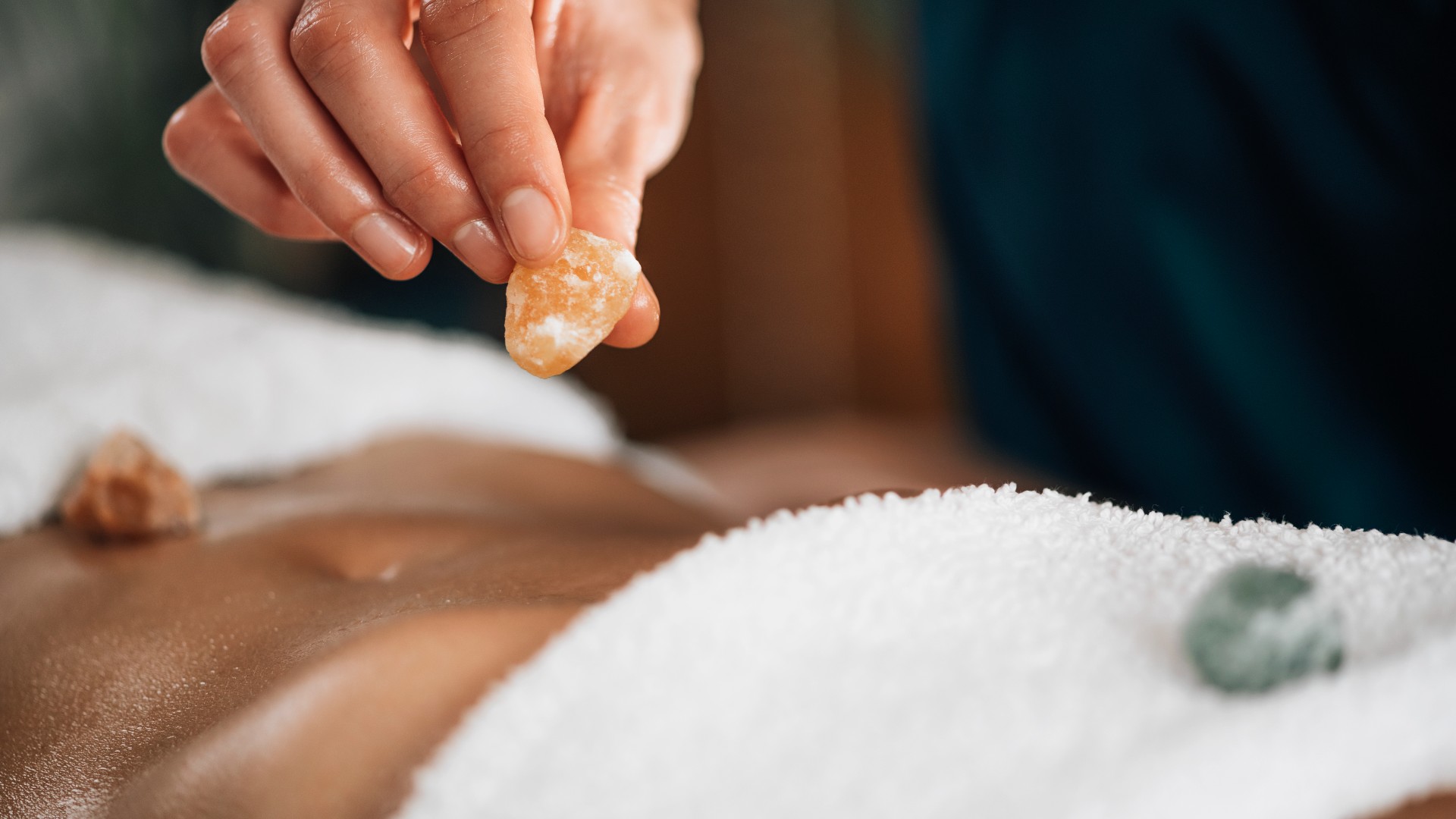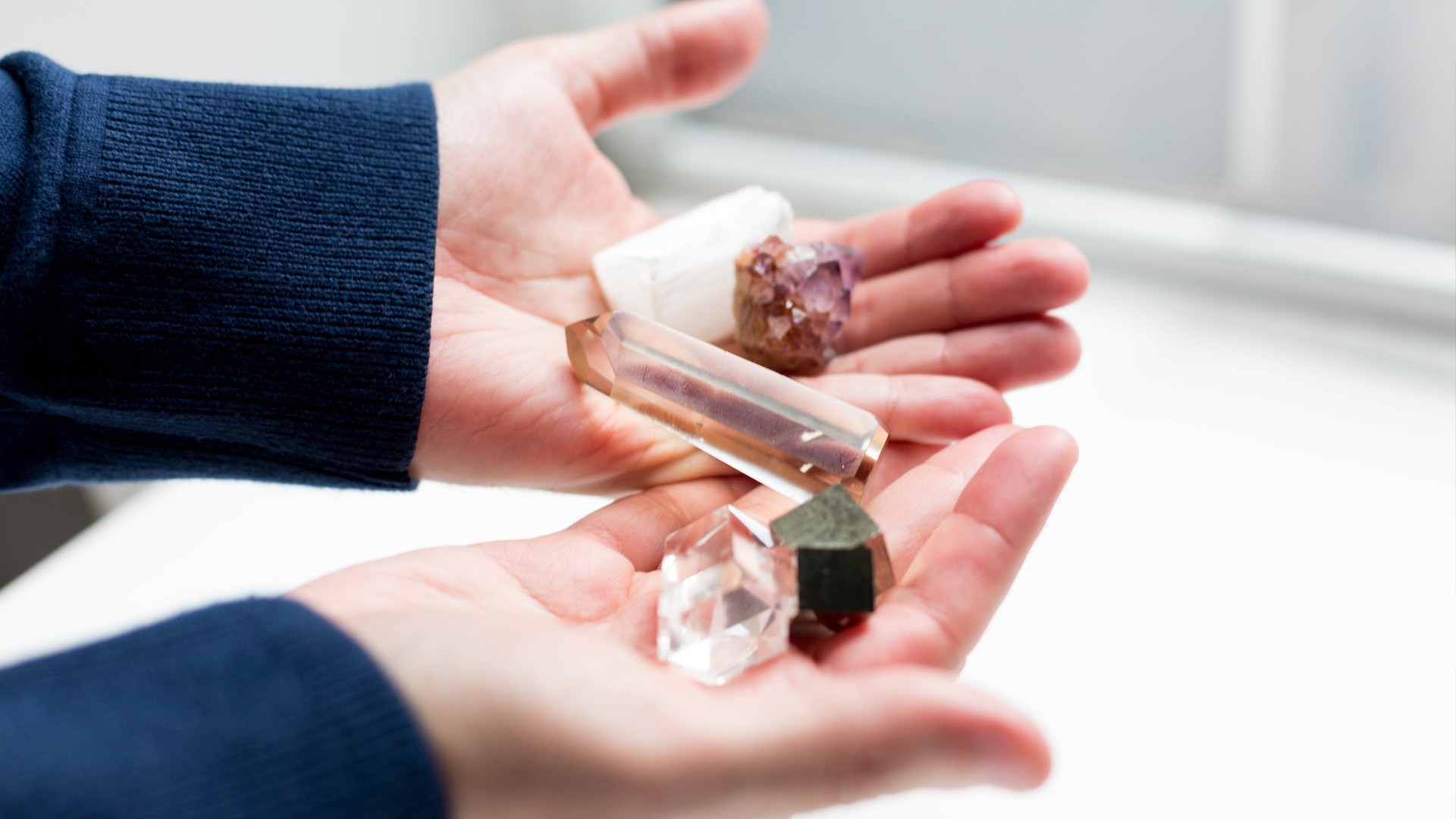Crystal healing: Stone-cold facts about gemstone treatments
Crystal healing is an alternative medicine technique that is supposed to tap into natural healing energy.

Crystal healing is an alternative medical technique in which crystals and other stones are used to cure ailments and protect against disease. Proponents of this technique believe that crystals act as conduits for healing — enabling positive, healing energy to flow into the body as negative, disease-causing energy flows out.
But despite the fact that crystal healing has seen an upsurge in popularity in recent years, this alternative treatment is not popular with most medical doctors and scientists, many of whom refer to crystal healing as a pseudoscience.
Scientifically speaking, there is no evidence that crystal healing can be used to cure diseases, because diseases have never been found to be the result of a so-called energy flow in the body. Furthermore, no scientific studies have shown that crystals and gems can be differentiated by chemical composition or color to treat a particular ailment.
"I am not aware of any [National Science Foundation]-supported studies into the healing powers of crystals," Peter Heaney, a mineral sciences professor at Pennsylvania State University, told the "Washington Post" in 2021. He goes on to explain that while crystals can be said to have energy, in accordance with Albert Einstein's mass-energy equivalence of e=mc^2, there is no energy transfer between crystals and human beings.
Nevertheless, healing crystals remain popular at health spas and at New Age health clinics, sometimes incorporated into related practices of massage and Reiki. The use of crystals in such environments may help induce relaxation, although this effect is also not backed by scientific evidence.
How crystal healing is supposed to work
Crystal healing proponents believe that crystals and gemstones have properties that facilitate healing. Many sites promoting crystal healing allege that the history of this practice is ancient, dating back at least 6,000 years to the time of the ancient Sumerians of Mesopotamia. Ancient Egyptians are also referenced on such sites as being among the first people to have adorned themselves with crystals — including lapis lazuli, carnelian and turquoise — to ward off illness and negative energy.
But the philosophy of modern crystal healing is based on traditional concepts borrowed from Asian cultures, most notably the Chinese concept of life-energy (chi or qi) and the Hindu or Buddhist concept of chakras, which are vortices of this life-energy, said to connect the physical and supernatural elements of the body.
Get the world’s most fascinating discoveries delivered straight to your inbox.
According to these philosophies, crystals are supposed to interact with the energy field of the body, promoting physical, emotional and spiritual healing, according to "Time."
In crystal healing, stones are assigned various properties, though healers have different ideas about which stones possess which properties. Amethyst, for example, is believed by some to be beneficial for the intestines, explains Healthline; green aventurine helps the heart; yellow topaz provides mental clarity. Colors red through violet are associated with seven chakra points on the body.
During a treatment session, a crystal healer may place various stones or crystals on your body aligned with these chakra points, roughly in the regions above the head, on the forehead, on the throat, on the chest, on the stomach, on the gut, and on the genital area. The stones used and their positioning may be chosen for the symptoms reported by the patient. This is all influenced by the healer's knowledge of, and belief in, the chakra philosophy of disease and energy imbalances — a philosophy that is largely dismissed by practitioners of Western medicine.
Crystal healing also involves the use of crystals and stones worn on the body or placed under pillows to ward off sickness, shed negative energy or absorb positive energy, according to Crystal Vaults, a company that sells such crystals, which it refers to as "talismans" or "amulets."
How crystal healing actually works
While there are no scientific studies on the efficacy of crystal healing, there is a study that suggests that crystal healing may induce a placebo effect in a patient who receives this type of treatment. Placebo effects accompany a treatment that are not directly due to the treatment itself acting on the disease of the patient, according to Christopher French, head of the anomalistic psychology research unit at the University of London.
"There is no evidence that crystal healing works over and above a placebo effect," French told Live Science. "That is the appropriate standard to judge any form of treatment. But whether or not you judge crystal healing, or any other form of [complementary and alternative medicine], to be totally worthless depends upon your attitude to placebo effects."
In other words, a person may feel better after undergoing crystal healing treatment, but there is no scientific proof that this result has anything to do with the crystals being used during the treatment. In 2001, French and his colleagues presented a paper at the British Psychological Society Centenary Annual Conference in Glasgow, in which they outlined their study of the efficacy of crystal healing.
For the study, 80 participants were asked to meditate for five minutes while holding either a real quartz crystal or a fake crystal that they believed was real. Before meditating, half of the participants were primed to notice any effects that the crystals might have on them, like tingling in the body or warmth in the hand holding the crystal.
After meditating, participants answered questions about whether they felt any effects from the crystal healing session. The researchers found that the effects reported by those who held fake crystals while meditating were no different than the effects reported by those who held real crystals during the study.
Many participants in both groups reported feeling a warm sensation in the hand holding the crystal or fake crystal, as well as an increased feeling of overall well being. Those who had been primed to feel these effects reported stronger effects than those who had not been primed. However, the strength of these effects did not correlate with whether the person in question was holding a real crystal or a fake one. Those who believed in the power of crystals (as measured by a questionnaire) were twice as likely as non-believers to report feeling effects from the crystal.
As French pointed out, there are many forms of treatment that are known to have no therapeutic effect other than a placebo effect. However, while these treatments might make you feel better temporarily, there is no proof that they can actually cure diseases or treat health conditions. If you're suffering from a serious medical issue, you should seek treatment from a licensed physician, not an alternative healer, French said.
Despite all of this, convincing someone who believes in the healing properties of crystals can be challenging. "It’s hard to argue against people who believe in the psychological effects of crystals […] Those are genuine experiences we have to respect," Zhuo Job Chen, professor in the psychology of religion at the University of North Carolina, told the Washington Post.
Others feel that people moving towards so-called alternative medicine shows a growing distrust of professional doctors that should encourage more empathy within the medical professions. "The present popularity of complementary and alternative medicine is also inviting criticism of what we are doing in mainstream medicine. It shows that we aren't fulfilling a certain need — we are not giving patients enough time, compassion, or empathy," Edzard Ernst, emeritus professor of Complementary Medicine at the Peninsula School of Medicine, University of Exeter, told the "British Medical Journal" in 2018.

Is crystal healing safe?
Crystal healers become healers by passing a certification course, often offered over the Internet from "natural medicine" universities or clinics, many of which are not accredited by any central organization. Currently, there are no state or federal laws that regulate or standardize the practice of crystal healing or the licensing of crystal healers specifically. In some states, this type of alternative treatment may fall under the category of massage or bodywork therapy. In those states, crystal healers may be required to obtain a license in order to practice their trade.
Non-profit organizations such as the National Certification Board for Therapeutic Massage & Bodywork (NCBTMB) also administer voluntary board certification exams for massage therapists and alternative healers. NCTMB endorses schools and businesses that offer certification to alternative healers, but only if they fulfill certain criteria established by the organization.
Some medical doctors tolerate crystal healing to a limited degree, seeing it as a therapy that can induce relaxation, which ultimately is therapeutic for stress management. Those seeking a crystal healer, however, should be careful not to forgo legitimate treatment for life-threatening disease.
Many parents also use Baltic amber necklaces for teething infants and toddlers, believing that the amber itself will help to take the teething pain away, similarly to the use of other gemstones to cure other ailments. According to Healthy Children, there is no scientific evidence that the amber works to subside teething pain. There are two theories that explain how the amber supposedly works: one is that a pain-relieving substance (succinic acid) is released from the amber by the heat of the baby's skin and is absorbed through the skin into the blood stream, and two, the amber stimulates the thyroid gland to increase drooling and reduce inflammation in the ears, throat, stomach and respiratory system.
John Snyder, a pediatrician who wrote an article about amber necklaces on the website Science-Based Medicine, listed several claims that are made about amber necklaces and how they may help lessen pain. The only claims that Snyder said were the slightest bit plausible were that it is known that Baltic amber does contain succinic acid, that some molecules are absorbed through the skin, and that succinic acid is naturally found in the human body. The amount of succinic acid in the amber, however, exists in minuscule amounts and body heat does not release it from the amber. There is also little to no evidence that succinic acid produces a therapeutic effect.
A 2016 letter to the editor published in the Journal of Pediatrics and Child Health by Alexandra Hudson, Kim Blake and Robyn McLaughlin discusses how the dangers of amber necklaces outweigh the very slim potential of benefit. The primary concerns with the necklaces are strangulation and choking, and several documented cases exist. The authors point out that both the Canadian Pediatric Society and American Academy of Pediatrics recommend against using the amber necklaces and recommend that parents are properly educated about teething and the use of amber healing.
Besides the potential dangers to the patients choosing crystal healing over traditional medicine there are also the dangers involved in the production of crystals to be considered. Mines in some of the poorest places in the world are where some of the gemstones are being sourced according to a 2019 report in "The Guardian." Madagascar, for example, saw a 170 percent increase in exports of gems and precious metals between 2016 and 2017, making it one of the top producers alongside much larger countries like India and China. However, 80 percent of crystals are mined by small groups and families for little money and without regulation in regions with poor access to water, electricity or other amenities.
Additional resources
For some really interesting crystals we recommend you read about time crystal made inside Google's quantum computer.
Alternatively, learn more about the bizarre crystals made as a result of the first nuclear bomb test in 1945.
Bibliography
- "‘Healing’ crystals are having a pandemic moment. But science says they’re just pretty stones," by Amanda McCracken, "The Washington Post"
- "What is Reiki?" by Elizabeth Palermo, Live Science
- "You Asked: Do Healing Crystals Actually Work?" by Markham Heid, "Time"
- "Purported amethyst powers for healing," Healthline
- "Empathy and ethics: five minutes with Edzard Ernst," by Abi Rimmer, "BMJ: British Medical Journal, Vol. 360"
- "Teething Necklaces and Beads: A Caution for Parents," HealthyChildren.com (from the American Academy of Pediatrics)
- "Amber Waves of Woo," by John Snyder, Science-Based Medicine
- "Amber jewellery: A dangerous popular trend for toddlers during their teething months and beyond," by Alexandra Hudson, Kim Blake, and Robyn McLaughlin, Wiley Online Library
- "Dark crystals: the brutal reality behind a booming wellness craze," by Tess McClure, "The Guardian"
- Rachel RossLive Science Contributor


